Since fears of manmade global warming — and potential legislation or regulations of carbon dioxide emissions — are based mostly upon the output of climate models, it is important for people to understand the basics of what climate models are, how they work, and what their limitations are.
Climate Models are Computer Programs
Generally speaking, a climate model is a computer program mostly made up of mathematical equations. These equations quantitatively describe how atmospheric temperature, air pressure, winds, water vapor, clouds, and precipitation all respond to solar heating of the Earth’s surface and atmosphere. Also included are equations describing how the so-called “greenhouse” elements of the atmosphere (mostly water vapor, clouds, carbon dioxide, and methane) keep the lower atmosphere warm by providing a radiative ‘blanket’ that partly controls how fast the Earth cools by loss of infrared to outer space.
The equation computations are made at individual gridpoints on a three-dimensional grid covering the Earth (see image below).
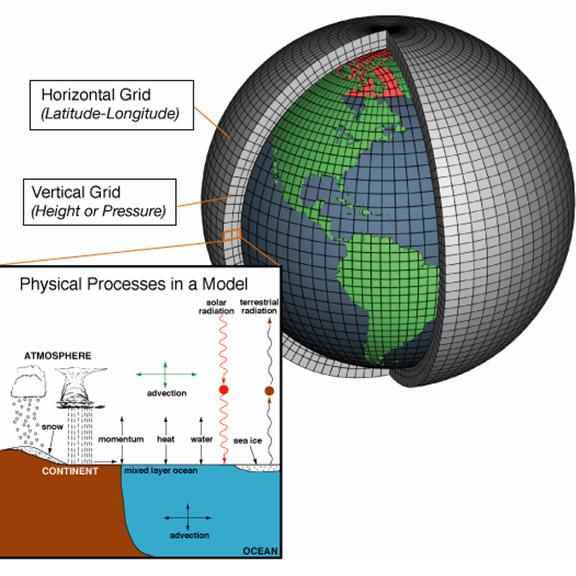
In “coupled” climate models, there are also equations describing the three-dimensional oceanic circulation, how it transports absorbed solar energy around the Earth, and how it exchanges heat and moisture with the atmosphere. Modern coupled climate models also include a land model that describes how vegetation, soil, and snow or ice cover exchange energy and moisture with the atmosphere.
You can make computer visualizations of how these processes evolve as the model is run on the computer, such as the nice example shown below produced by Gary Strand at the National Center for Atmospheric Research (NCAR). This particular image shows sea surface temperatures, near-surface winds, and sea ice concentrations in one of the NCAR models at some point during a run of the model on a supercomputer. [Note the model does not have an actual physical shape in the computer…it is just a long series of computations.]
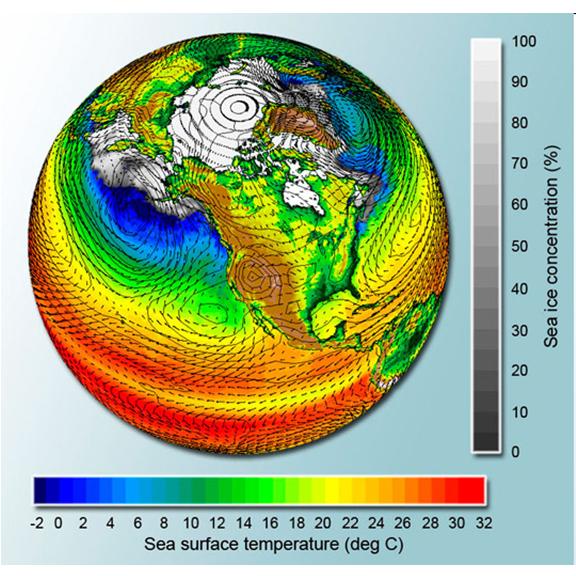
If you want to see how a climate model simulation evolves over time, a striking YouTube video of the NCAR CCSM climate model is shown here.
The Importance of Energy Balance in Climate Models
Climate models are usually used to study how the Earth’s climate might respond to small changes in either the intensity of sunlight being absorbed by the Earth, or in the case of anthropogenic global warming, the addition of manmade greenhouse gases that further reduce the atmosphere’s ability to cool to outer space.
For it is the balance between these two flows of radiant energy – solar energy in, and infrared energy out of the climate system — that is believed to control the average temperature of the climate system over the long run. If the two radiant energy flows are in balance, then the average temperature of the climate system remains pretty constant. If they are out of balance, the average temperature of the climate system can be expected to change.
If this fundamental concept of “energy balance” sounds foreign to you, it shouldn’t because it is part of your everyday experience. For instance, the temperature of a pot of water warming on the stove will only increase as long as the rate of energy gain from the stove is greater than the rate of energy loss by the pot to its surroundings. Once the pot warms to the point where the rate of energy loss equals the rate of energy gain, its temperature then will remain constant.
Similarly, the temperature of the inside of a car sitting in the sun will increase only until the rate at which sunlight is absorbed by the car equals the rate at which heat is lost by the hot car to its surroundings.
In the same manner, any imbalance in the average flows of energy in and out of the climate system can be expected to cause a temperature change. When averaged over the whole Earth, the rates of absorbed solar energy and infrared energy lost are estimated to be about 235 or 240 Watts per square meter. I say “estimated” because our satellite system for measuring the radiative energy budget of the Earth is still not quite good enough to measure it to this level of absolute accuracy.
A variety of adjustable parameters in the model are tuned until the model approximates the average seasonal change in weather patterns around the world, and also absorbs sunlight and emits infrared energy to space at a global-average rate of about 235 or 240 Watts per sq. meter. The modelers tend to assume that if the model does a reasonably good job of mimicking these basic features of the climate system, then the model will be able to predict global warming. This might or might not be a good assumption – no one really knows.
It is also important to understand that even if a climate model handled 95% of the processes in the climate system perfectly, this does not mean the model will be 95% accurate in its predictions. All it takes is one important process to be wrong for the models to be seriously in error. For instance, how the model alters cloud cover with warming can make the difference between anthropogenic global warming being catastrophic, or just lost in the noise of natural climate variability.
Anthropogenic Global Warming in Climate Models
Our addition of carbon dioxide to the atmosphere by burning fossil fuels is estimated to have caused an imbalance of about 1.5 Watts per sq. meter between the 235 to 240 Watts per sq. meter of average absorbed sunlight and emitted infrared radiation. The extra CO2 makes the infrared greenhouse blanket covering the Earth slightly thicker. This energy imbalance is too small to be measured from satellites; it must be computed based upon theory.
So, if the Earth was initially in a state of energy balance, and the rate of sunlight being absorbed by the Earth was exactly 240 Watts per sq. meter, then the rate of infrared loss to outer space would have been reduced from 240 Watts per sq. meter to 238.5 Watts per sq. meter (240 minus 1.5).
This energy imbalance causes warming in the climate model. And since a warmer Earth (just like any warmer object) loses infrared energy faster than a cool object, the modeled climate system will warm up until energy balance is once again is restored. At that point, the rate at which infrared energy is lost to space once again equals the rate at which sunlight is absorbed by the Earth, and the temperature will once again remain fairly constant.
What Determines How Much the Model will Warm?
The largest source of uncertainty in climate modeling is this: will the climate system act to reduce, or enhance, the small amount of CO2 warming?
The climate model (as well as the real climate system) has different ways in which an energy imbalance like that from adding CO2 to the atmosphere can be restored. The simplest response would be for the temperature alone to increase. For instance, it can be calculated theoretically that the ~40% increase in atmospheric CO2 humans are believed to have caused in the last 150 years would only cause about 0.5 deg. C warming to restore energy imbalance. This theoretical response is called the “no feedback” case because nothing other than temperature changed.
But a change in temperature can be expected to change other elements of the climate system, like clouds and water vapor. These other, indirect changes are called feedbacks, and they can either amplify the CO2-only warming, or reduce it. As shown in the following figure, all 20+ climate models currently tracked by the United Nations’ Intergovernmental Panel on Climate Change (IPCC) now amplify the warming.
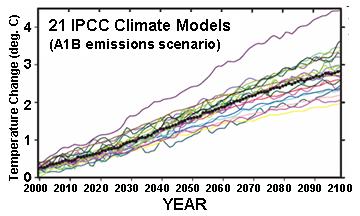
This amplification is mostly through an increase in water vapor — Earth’s main greenhouse gas — and through a decrease in low- and middle-altitude clouds, the primary effect of which is to let more sunlight into the system and cause further warming. These indirect changes in response to warming are called feedbacks. The models amplify the CO2 warming with positive water vapor feedback, and with positive cloud feedback.
But is this the way that the real climate system operates?
Uncertainties in Climate Model Cloud and Water Vapor Processes
The climate model equations are only approximations of the physical processes that occur in the atmosphere. While some of those approximations are highly accurate, some of the most important ones from the standpoint of climate change are unavoidably crude. This is because the real processes they represent are either (1) too complex to include in the model and still have the model run fast on a computer, or (2) because our understanding of those processes is still too poor to accurately model them with equations.
This is especially true for cloud formation and dissipation, which in turn has a huge impact on how much sunlight is absorbed by the climate system. The amount of cloud cover generated in the model in response to solar heating helps control the Earth’s temperature, so the manner in which clouds change with warming is of huge importance to global warming predictions.
Climate modelers are still struggling to get the models to produce cloud cover amounts and types like those seen in different regions, and during different seasons. The following NASA MODIS image of the western U.S. and eastern Pacific Ocean shows a wide variety of cloud types which are controlled by a variety of different processes.
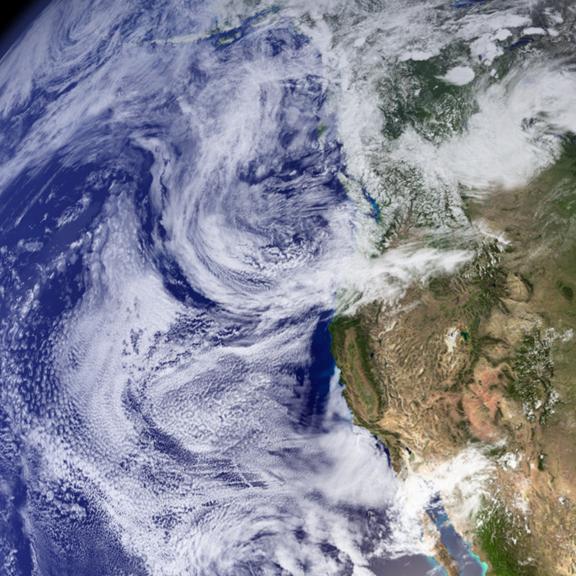
The complexity of clouds is intuitively understood by everyone, experts and non-experts alike. It is probably safe to say that all climate modelers recognize that the modeling of cloud behavior accurately is very difficult, and is something which has not yet been achieved in global climate models.
All of the IPCC climate models reduce low- and middle-altitude cloud cover with warming, a positive feedback. This is the main reason for the differences in warming produced by different climate models (Trenberth and Fasullo, 2009). I predict that this kind of model behavior will eventually be shown to be incorrect. And while the authors were loathe to admit it, there is already some evidence showing up in the peer-reviewed scientific literature that this is the case (Spencer et al., 2007; Caldwell and Bretherton, 2009).
I believe that the modelers have mistakenly interpreted decreased cloud cover with warming in the real climate system as positive cloud feedback (warming causing a cloud decrease), when in reality it was actually the decrease in clouds that mostly caused the warming. This is basically an issue of causation: one direction of causation has been ignored when trying to estimate causation in the opposite direction (Spencer and Braswell, 2008).
The fundamental issue of causation in climate modeling isn’t restricted to just clouds. While warming will, on average, cause an increase in low-level water vapor, precipitation systems control the water vapor content of most of the rest of the atmosphere. As shown in the following illustration, while evaporation over most of the Earth’s surface is continuously trying to enhance the Earth’s natural greenhouse effect by adding water vapor, precipitation is continuously reducing the greenhouse effect by converting that water vapor into clouds, then into precipitation.
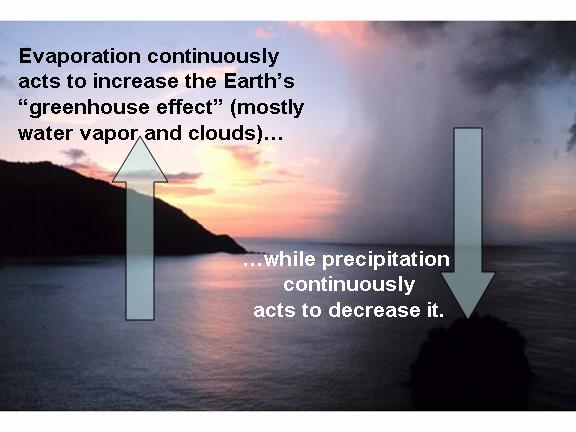
But while the physics of evaporation at the Earth’s surface is understood pretty well, the processes controlling the conversion of water vapor into precipitation in clouds are complex and remain rather mysterious. And it is the balance between these two processes — evaporation and precipitation — that determines atmospheric humidity.
Even in some highly complex ‘cloud resolving models’ – computer models that use much more complex computations to actually ‘grow’ clouds in the models – the point at which a cloud starts precipitating in the model is given an ad hoc constant value. I consider this to be a huge source of uncertainty, and one that is not appreciated even by most climate modelers. The modelers tune the models to approximate the average relative humidity of the atmosphere, but we still do not understand from ‘first principles’ why the average humidity has its observed value. We would have to thoroughly understand all of the precipitation processes, which we don’t.
In the end, many of the approximations in climate models will probably end up being not very important for forecasting climate change…but it takes only one critical process to be wrong for model projections of warming to be greatly in error. The IPCC admits that their largest source of uncertainty is low cloud feedback, that is, how low cloud cover will change with warming. And, as just mentioned, I believe how precipitation efficiency might change with temperature is also a wild card in climate model predictions.
Sources of Global Warming: Humans or Nature?
At this point hopefully you understand that climate modelers think global warming is the result of humans ‘upsetting’ the Earth’s radiative energy balance. And I agree with them that adding more carbon dioxide to the atmosphere must have some effect…but how large is this change in comparison the energy imbalances the climate system imposes upon itself?
It turns out that the modelers have made a critical assumption that ends up leading to the their conclusion that the climate system is very sensitive to our greenhouse gas emissions: that the climate system was in a state of energy balance in the first place.
There is a pervasive, non-scientific belief in the Earth sciences that nature is in a fragile state of balance. Whether it is ecosystems or the climate systems, you will hear or read scientists claims about the supposed fragility of nature.
But this is a subjective concept, not a scientific one. Still, it makes its way into the scientific literature (read the abstract to this seminal paper on the first satellite measurements of the Earth’s energy budget…look for “delicately balanced”). Just because nature tends toward a balance does not mean that balance is in any way ‘fragile’. And what does ‘fragile’ even mean when nature itself is always upsetting that balance anyway?
Why is this important to climate modeling? Because if climate researchers ignore naturally-induced climate variability, and instead assume that most climate changes are due to the activity of humans, they will inevitably come to the conclusion that the climate system is fragile: that is, that feedbacks are positive. It’s a little like some ancient tribe of people believing that severe weather events are the result of their moral transgressions.
If the warming observed during the 20th Century was due to human greenhouse gas emissions, then the climate system must be pretty sensitive (positive feedbacks). But if the warming was mostly due to a natural change in cloud cover, then the climate system is more likely to be insensitive (negative feedbacks). And there is no way to know whether natural cloud changes occurred during that time simply because our global cloud observations over the last century are nowhere near accurate enough.
So, climate modelers simply assume that there are no natural long-term changes in clouds, water vapor, etc. But they do not realize that in the process they will necessarily come to the conclusion that the climate system is very sensitive (feedbacks are positive). As a result, they program climate models so that they are sensitive enough to produce the warming in the last 50 years with increasing carbon dioxide concentrations. They then point to this as ‘proof’ that the CO2 caused the warming, but this is simply reasoning in a circle.
Climate modelers have simply assumed that the Earth’s climate system was in a state of energy balance before humans started using fossil fuels. But as is evidenced by the following temperature reconstruction for the last 2,000 years (from Loehle, 2007), continuous changes in temperature necessarily imply continuous changes in the Earth’s energy balance.
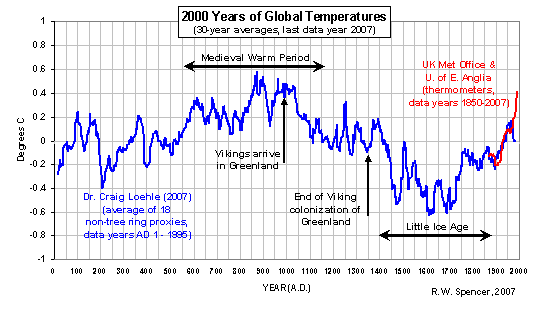
And while changes in solar activity are one possible explanation for these events, it is also possible that there are long-term, internally-generated fluctuations in global energy balance brought about by natural cloud or water vapor fluctuations. For instance, a change in cloud cover will change the amount of sunlight being absorbed by the Earth, thus changing global temperatures. Or, a change in precipitation processes might alter how much of our main greenhouse gas — water vapor — resides in the atmosphere. Changes in either of these will cause global warming or global cooling.
But just like the tribe ancient people not understanding that there are physical processes at work in nature that cause storms to occur, climate modelers tend to view climate change as something that is largely human in origin – presumably the result of our immoral burning of fossil fuels.
Faith-Based Climate Modeling
There is no question that much expense and effort has gone into the construction and improvement of climate models. But that doesn’t mean those models can necessarily predict climate 20, 50, or 100 years from now. Ultimately, the climate researcher (and so the politician) must take as a matter of faith that today’s computerized climate models contain all of the important processes necessary to predict global warming.
This is why validating the predictions of any theory is so important to the progress of science. The best test of a theory is to see whether the predictions of that theory end up being correct. Unfortunately, we have no good way to rigorously test climate models in the context of the theory that global warming is manmade. While some climate modelers will claim that their models produce the same “fingerprint” of manmade warming as seen in nature, there really is no such fingerprint. This is because warming due to more carbon dioxide is, for all practical purposes, indistinguishable from warming due to, say, a natural increase in atmospheric water vapor.
The modeler will protest, “But what could cause such a natural change in water vapor?” Well, how about just a small change in atmospheric circulation patterns causing a decrease in low cloud cover over the ocean? That would cause the oceans to warm, which would then warm and humidify the global atmosphere (Compo and Sardeshmukh, 2009). Or how about the circulation change causing a change in wind shear across precipitation systems? This would lead to a decrease in precipitation efficiency, leading to more water vapor in the atmosphere, also leading to a natural ‘greenhouse’ warming (Renno et al., 1994).
To reiterate, just because we don’t understand all of the ways in which nature operates doesn’t mean that we humans are responsible for the changes we see in nature.
The natural changes in climate I am talking about can be thought of as ‘chaos’. Even though all meteorologists and climate researchers agree that chaos occurs in weather, climate modelers seem to not entertain the possibility that climate can be chaotic as well (Tsonis et al., 2007). If they did believe that was possible, they would then have to seriously consider the possibility that most of the warming we saw in the 20th Century was natural, not manmade. But the IPCC remains strangely silent on this issue.
The modelers will claim that their models can explain the major changes in global average temperatures over the 20th Century. While there is some truth to that, it is (1) not likely that theirs is a unique explanation, and (2) this is not an actual prediction since the answer (the actual temperature measurements) were known beforehand.
If instead the modelers were NOT allowed to see the temperature changes over the 20th Century, and then were asked to produce a ‘hindcast’ of global temperatures, then this would have been a valid prediction. But instead, years of considerable trial-and-error work has gone into getting the climate models to reproduce the 20th Century temperature history, which was already known to the modelers. Some of us would call this just as much an exercise in statistical ‘curve-fitting’ as it is ‘climate model improvement’.
The point is that, while climate models currently offer one possible explanation for climate change (humanity’s greenhouse gas emissions), it is by no means the only possible one. And any modeler who claims they have found the only possible cause of global warming is being either disingenuous, or they have let their faith overpower their ability to reason.
Even the IPCC (2007) admits there is a 10% chance that they are wrong about humans being responsible for most of the warming observed in the last 50 years. That, by itself, shows that anyone who says “the science is settled” doesn’t know what they are talking about.
Conclusion
There is no question that great progress has been made in climate modeling. I consider computer modeling to be an absolutely essential part of climate research. After all, without running numbers through physical equations in a theoretically-based model, you really can not claim that you understand very much about how climate works.
But given all of the remaining uncertainties, I do not believe we can determine — with any objective level of confidence — whether any of the current model projections of future warming can be believed. Any scientist who claims otherwise either has political or other non-scientific motivations, or they are simply being sloppy.
REFERENCES CITED:
Caldwell, P., and C. S. Bretherton, 2009. Response of a subtropical stratocumulus-capped mixed layer to climate and aerosol changes. Journal of Climate, 22, 20-38.
Compo, G.P., and P. D. Sardeshmukh, 2009. Oceanic influences on recent continental warming, Climate Dynamics, 32, 333-342.
Intergovernmental Panel on Climate Change, 2007. Climate Change 2007: The Physical Science Basis, report, 996 pp., Cambridge University Press, New York City.
Loehle, 2007. A 2,000 year global temperature reconstruction on non-treering proxy data. Energy & Environment, 18, 1049-1058.
Renno, N.O., K.A. Emanuel and P.H. Stone, 1994. A Radiative-convective model
with an explicit hydrologic cycle: 1.Formulation and sensitivity to model parameters.
Journal of Geophysical Research, 99, 14,429-14,441
Spencer, R.W., W. D. Braswell, J. R. Christy, and J. Hnilo, 2007. Cloud and radiation budget changes associated with tropical intraseasonal oscillations, Geophys. Res. Lett., 34, L15707 doi:10.1029/2007GL029698.
Spencer, R.W., and W.D. Braswell, 2008. Potential biases in cloud feedback diagnosis: A
simple model demonstration, J. Climate, 21, 5624-5628.
Trenberth, K.E.., and J.T. Fasullo, 2009. Global warming due to increasing absorbed solar radiation. Geophysical Research Letters, 36, L07706, doi:10.1029/2009GL037527.
Tsonis, A. A., K. Swanson, and S. Kravtsov, 2007. A new dynamical mechanism for major climate shifts. Geophysical Research Letters, 34, L13705, doi:10.1029/2007GL030288.


 Home/Blog
Home/Blog









